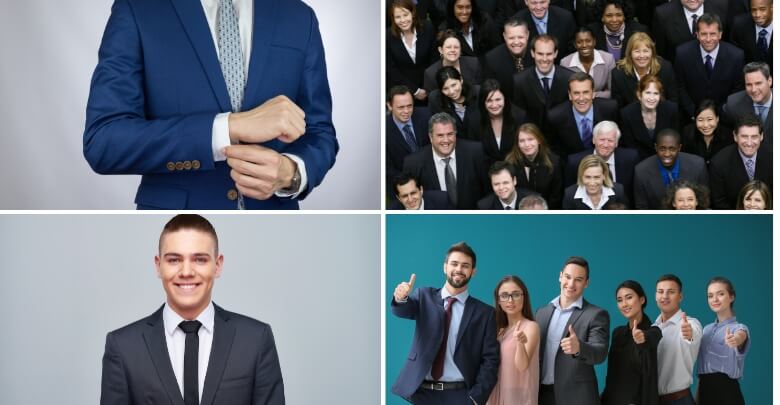Attending a healthcare conference is an exciting opportunity to learn from industry experts, network with peers, and stay updated on the latest advancements in healthcare. When you preparing for such an event, one common question arises: “What should I wear to a healthcare conference?”
For a healthcare conference, you should wear business or business casual attire. Men can wear a suit jacket, dress pants, shirt, and tie. Women have options like dresses, skirts with blouses, or dress pants with blouses. Dress professionally to convey competence and respect for the event.
Wondering about specific tips and additional details to perfect your conference attire? Follow the rest of the article to ensure you make the best impression.
Is Dress Code Matters At Healthcare Conferences?
Dress code is a significant aspect of professional events, including healthcare conferences. It sets the tone for the event, reflecting its level of formality and professionalism. Attendees are often encouraged to dress in business attire, which helps create a respectful and serious environment conducive to learning and networking.

At international healthcare conferences, the importance of dress code is even more pronounced. These events bring together professionals from various cultures and backgrounds, each with their expectations regarding professional attire.
For example, adhering to a formal dress code at international health care conferences in Canada demonstrates respect for the diverse participants and fosters an atmosphere of professionalism and credibility. Dressing appropriately can enhance personal branding and make a positive impression on peers and potential collaborators.
Why is Professional Attire Important for A Conference?
Dressing appropriately for a conference requires careful consideration. Professional attire is more than just clothing; it’s a statement of your seriousness and respect. Your conference experience can be significantly improved if you understand its importance.
Improves First Impressions
Your first impression is crucial at a conference. Professional attire helps you make a positive impact immediately. People often judge your competence based on your appearance. Dressing well can open doors to meaningful connections.
Reflects Your Professionalism
Wearing professional attire reflects your commitment to your field. It shows that you take the event seriously. This perception can influence how others interact with you. Respect for the conference translates into respect from your peers.
Builds Confidence
Dressing professionally boosts your self-confidence. Knowing you look the part can ease anxiety. Confidence in your appearance can improve your communication skills. It helps you engage more effectively with others.
Establishes Credibility
Professional attire establishes your credibility in your industry. It signals that you belong in a professional setting. Credibility can be a deciding factor in networking opportunities. Your appearance can reinforce your professional identity.
Improves Networking Opportunities
Conferences are prime networking opportunities. Professional attire makes you approachable and respected. It encourages others to engage with you seriously. Good impressions can lead to valuable connections and opportunities.
Contributes to a Positive Environment
Your attire contributes to the overall atmosphere of the conference. Professional attire encourages others to dress similarly. This collective effort increases the event’s tone. A professional environment promotes productive interactions.
Demonstrates Respect for the Event
Wearing appropriate attire shows respect for the conference and its organizers. It acknowledges their efforts in creating a formal event. Respecting the dress code honors their work. It’s a small gesture with a significant impact.
What Should I Wear to A Healthcare Conference?
Attending a healthcare conference requires careful thought about what to wear. Your attire can significantly impact how you are perceived and can improve your professional image. By dressing appropriately, you can maximize health care conference experience, ensuring you feel confident and comfortable. The dress code helps you make the best choices for a successful event.
Identifying Appropriate Business Attire
Business attire is often the standard for healthcare conferences. Men can opt for a suit jacket, dress pants, shirt, and tie. This combination conveys professionalism and seriousness. Women can choose dresses, skirts with blouses, or dress pants with blouses for a similar effect.
Choosing Business Casual
Business casual offers a slightly relaxed but still professional look. Men can wear dress pants with a collared shirt, adding a blazer if desired. Women might select a professional dress or a blouse with a skirt or slacks. This attire balances comfort with a polished appearance.
Colors and Patterns
Neutral colors like navy, black, and grey are safe choices. These colors are versatile and convey professionalism. Adding subtle patterns can showcase your personality without being too bold. Avoid overly bright or distracting colors to maintain a professional look.
Importance of Fit
Wearing well-fitted clothing is crucial for a polished appearance. Ensure that your clothes are tailored to your body type. Ill-fitting attire can look sloppy and unprofessional. Proper fit increases your confidence and comfort throughout the event.
Selecting Comfortable Shoes
Comfortable shoes are essential for long conference days. Men should choose polished dress shoes that offer support. Women can opt for professional flats or low heels. Prioritize comfort to avoid discomfort during extended periods of standing or walking.
Accessorizing Appropriately
Accessories should complement your outfit without overpowering it. Men can add a watch and a simple tie clip for a refined touch. Women might wear understated jewelry and a professional handbag. Keep accessories minimal to maintain a sophisticated look.
Preparing for Different Settings
Be ready for various conference settings and activities. Layering can help you adjust to different temperatures within the venue. A blazer or cardigan can be easily removed if needed. Consider the event’s schedule to ensure your attire is versatile and suitable.
What Are the Best Colors to Wear at A Healthcare Conference?
Choosing the right colors for a healthcare conference can improve your professional appearance and boost confidence. Here are the best colors to consider:
- Navy Blue: A versatile and professional color that conveys trustworthiness and authority. It’s a safe choice for both suits and dresses.
- Black: Timeless and sophisticated, black is always appropriate. It exudes elegance and professionalism, making it ideal for formal settings.
- Gray: A neutral color that is less intense than black but still very professional. Light or dark shades of gray are perfect for suits, skirts, and blouses.
- White: Clean and crisp, white shirts or blouses pair well with darker suits and create a sharp, polished look. It symbolizes clarity and simplicity.
- Pastel Colors: Light pastel shades like soft blue, lavender, or mint green can be refreshing and approachable. These colors are subtle yet add a touch of personality.
- Burgundy or Deep Red: A deep red or burgundy can add a pop of color while maintaining a professional appearance. It signifies confidence and decisiveness.
- Earth Tones: Colors like beige, brown, and olive can be professional yet less formal. They are great for business casual attire and convey warmth and reliability.
Tips to Help You Be Prepared for a Healthcare Conference
Attending a healthcare conference can be a rewarding experience when planned well. Preparation helps you learn, connect, and make meaningful progress toward your goals. To make the most of the event, consider organizing your materials and setting specific intentions. Here are some useful tips to help you prepare for your next healthcare conference.
Set Clear Goals
Start by identifying what you want to achieve, such as networking or gaining insights into emerging healthcare trends. Having specific goals allows you to focus your time and energy effectively. For example, if attending health care conferences as a non-medical professional, define your objectives early. Knowing what you want makes every conversation and session more meaningful.
Research the Event Thoroughly
Spend time researching the speakers, key topics, and scheduled sessions before attending. This preparation ensures you prioritize sessions most relevant to your goals and interests. Understanding the themes also helps you engage better with discussions and activities. Researching in advance allows you to tailor your experience for maximum benefit.
Prepare Essential Materials
Gather important items like business cards, notebooks, or any relevant documents you might need during the conference. Make sure you’re prepared with any presentations, slides, or notes well in advance. Keeping your materials organized reduces stress and allows you to focus on the event. A checklist ensures you won’t forget anything critical before the big day.
Develop Strong Networking Strategies
Practice a concise elevator pitch that describes who you are and what you do. Plan ways to introduce yourself confidently to new connections and maintain conversations naturally. When networking, try to engage meaningfully rather than rushing to collect contacts. Preparing strategies in advance helps you build stronger professional relationships.
Plan a Well-Balanced Agenda
Structure your day to balance sessions, networking breaks, and some downtime. A well-planned agenda keeps you energized and avoids burnout during a packed schedule. Include time for connecting with key people or reflecting on sessions. This balance ensures you make the most of the conference without feeling overwhelmed.
Follow Up After the Event
Take time to review your notes and reflect on what you learned during the conference. Follow up with new contacts by sending emails or connecting on LinkedIn promptly. Thoughtful follow-ups keep the conversations alive and show professionalism. These connections could lead to future collaborations or opportunities.
FAQs for What Should I Wear to A Healthcare Conference?
Dressing appropriately for a healthcare conference is crucial for making a positive impression and maximizing your experience. Here are some frequently asked questions and their answers to help you prepare:
Can I Wear Jeans to A Healthcare Conference?
Jeans are generally not recommended for healthcare conferences. Business or business casual attire is preferred to maintain a professional image. Look for dress pants or skirts instead for a more polished look
Are Sneakers Acceptable at A Healthcare Conference?
Sneakers are typically not appropriate for healthcare conferences. Choose comfortable yet professional footwear like dress shoes or flats. These options ensure you maintain a polished appearance while staying comfortable.
Should I Consider the Venue when Choosing My Attire?
Consider the venue when selecting your attire. Different venues may have varying levels of formality. Ensure your outfit aligns with the setting to maintain appropriateness and professionalism.
Can Business Casual Be Appropriate for All Conference Days?
Yes, business casual can be appropriate for many conference days. It offers a balance of professionalism and comfort. However, always check the specific dress code guidelines provided by the conference organizers.
How Should I Dress for Networking Events at The Conference?
For networking events, dress slightly more formal than casual. Business attire or business casual is usually appropriate. This ensures you make a positive impression while engaging with peers and industry experts.
Closing Remarks
Dressing appropriately for a healthcare conference is essential for making a positive impression and maximizing your experience. It is typically required to wear business or business casual attire. Choosing well-fitting clothing in neutral colors like navy, black, and grey helps create a polished appearance.
You should consider comfort when selecting your conference attire. Comfortable shoes and breathable fabrics are vital for long days of networking and learning. Accessorizing with minimal and functional pieces can increase your look without overwhelming it, helping you maintain a sophisticated look.
You can improve your professional image by understanding “What should I wear to a healthcare conference?”. By dressing appropriately, you show respect for the event and its participants, ultimately contributing to a positive and productive environment. Conference attire can have a significant impact on networking opportunities.







